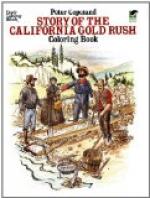But the leaping tuna pleased Tom the most, since he thought it such fun to watch them jump into the air like silver arrows after the flying-fish. Not so large as the black bass, the tunas are strong enough to tow a boat along when running with a hook. One will drag a heavy launch through the water as if a tug had hold of it, and will fight for hours, rushing and plunging till tired out. Then the fisherman pulls him up to the boat and ends his struggles.
Tom and Retta were fond of watching the curious fish and sea-plants in the glass aquarium tanks on shore also, but their happiest time was when they gathered shells on the beach. They never found out the names of more than those of the limpet, turban, and scallop, though they picked up baskets full of tiny pink and white beauties, all frail and of many kinds. These shells were once the homes of sea mollusks, as such soft, fleshy creatures are called. But to Tom and Retta the shells were only pretty playthings, to be doll’s dishes, or cups, or pincushions, perhaps.
One morning some fishermen saw a shark, and no one dared to go in bathing for a few days. This great, savage, “man-eater” shark does not often come north of the Gulf of California. Sometimes small ones are caught with a hook and line off Catalina Island, and Tom was always glad to see such sea-tigers destroyed.
Of course the children did not want to go home, till at last Mrs. Ransom explained to them that in the ocean and bay near San Francisco there were odd fish and strange animals too. And so it turned out, for in a day’s fishing over at Sausalito Tom caught many silver smelt and tomcod, with flat, ugly flounders, and a red, big-eyed rock-cod. The frightened boy almost fell out of the boat, too, when he pulled in a large sting-ray, or “stingaree,” as the boatman called it. This queer three-sided fish, with a sharp, bony sting in its back, flopped round till the man cut the hook out, knocked its head till it was no longer able to bite, and threw it overboard. These rays have to be fenced out of the oyster-beds along the bay, since they have big mouths full of such strong teeth that they crush an oyster, shell and all, and destroy every one they can reach.
Oysters are grown in great quantities in the oyster-beds along the bay shore. The largest size, which are called “transplanted,” are brought from the East as very small or baby oysters and dropped into shallow water, where they cling to rocks or brush-piles till grown.
Tom also caught a perch, and clinging to it as he drew in his line was a large, hard-shelled, long-clawed crab. Tom put the crab in the basket, knowing well what delicious white meat was in the fellow’s legs and back.
Clams that burrow deep in the mud and may be found at low tide, by digging where their tell-tale bubble of air arises, and the odd shrimps, so good to eat, the children already knew about. Chinese fishermen catch shrimps in nets, dry them on the hillsides, and send both dry meat and shells to China. They dry the meat of the abalone also, and use the beautiful shells, which you have no doubt seen, for carving into curios, or making into jewellery.




